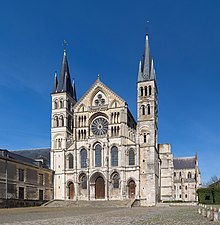Saint-Remi Abbey (Reims)
In the former royal abbey of Saint-Remi , the holy oil used to anoint the French kings at their coronation was kept for centuries. It now houses the Reims Municipal Historical Museum and was declared a World Heritage Site by UNESCO in 1991.
history
Since the 7th century, a religious community has formed at the grave of St. Remigius († 533). At the end of the 8th century the place was taken over by a group of monks who, under Archbishop Tilpin, adopted the Benedictine rules of the order around 790 . In 930 the monastery was heavily fortified to protect it from the invasions of the Normans and Hungarians . From 945, the monastery joined the reform movement of Cluny under Archbishop Hugo von Vermandois .
In 1049 the new abbey church was built over the saint's grave by Pope Leo IX. consecrated. After a fire in 1098 that partially destroyed the church, it was enlarged and embellished again in the 12th century under Abbot Odon.
From the 17th century, the abbey buildings were gradually replaced by new buildings in the Baroque style . Archbishop Charles Maurice Le Tellier awarded the building contract to the architect Jean Bonhomme. The last thing to do was a new cloister between 1709 and 1730 . The church, however, remained unchanged. On the night of January 15th to 16th, 1774, large parts of the convent buildings were destroyed by flames, but were rebuilt in the classicist style.
During the French Revolution , the monastery was closed in 1792 and the monks were expelled. A military hospital was initially housed in the convent buildings until 1816, then the city hospital.
Convent building
After the fire of 1774, they were rebuilt in the classical style by the court architect Louis Duroché . He was mainly responsible for the current facade of the abbey. During the renovations in the 18th century, the chapter room and the parlatorium were preserved in the Gothic style.
After the Second World War, the idea arose to build a city museum in the building. It was opened in August 1978 and contains, among other things, an archaeological collection mainly from the Roman period in the former refectory and kitchen from the 18th century. The collection also focuses on evidence from the history of the city and the abbey, such as B. a series of tapestries from the 16th century, which shows scenes from the life of St. Remigius . It was commissioned by Archbishop Robert II de Lénoncourt .
Abbey church
The abbey church was built over the (legendary) grave of St. Remigius and was the burial church of many archbishops and some Franconian and French kings, including Karlmann I († 771), Ludwig IV († 954) and Lothar († 986).
The double tower facade is framed by 56 m high towers, the southern one dating from the 11th century, the northern one being added during restorations in the 19th century. The vault of the church was destroyed during the First World War . The reconstruction took 40 years to 1958. The unadorned nave is 122 meters long and only 26 meters wide. The choir head surrounds an ambulatory with a chapel wreath. The church was initially flat-roofed and was only later vaulted, which can still be seen today from the wall transitions and the different stones. The nave looks a little squat.
While the wall structure in the nave with round arched arcades, galleries with large arched openings and the upper cladding windows above it encompasses three zones, the early Gothic choir was given a further zone with the triforium .
organ
The organ of the abbey church was built between 1991 and 2000. The instrument has 45 stops (including a transmission) on three manual works and a pedal. The game actions are mechanical, the stop actions are electric. A special feature are the manual compartments of the Rückpositiv, Grand Orgue and Pedal, which are connected to the Kontra-A, i.e. H. start below the capital C.
|
|
|
|
|||||||||||||||||||||||||||||||||||||||||||||||||||||||||||||||||||||||||||||||||||||||||||||||||||||||||||||||||||||||||||||||||||||||||||||||||||||||
- Coupling : I / II, III / II, II / III, I / P, II / P, III / P
Individual evidence
- ↑ On the history of the organ on the church music website (French)
- ↑ Information on disposition (French)
Web links
- Website of the basilica (French)
- Entry no.PA00078773 in the Base Mérimée of the French Ministry of Culture (French)
Coordinates: 49 ° 14 ′ 36 ″ N , 4 ° 2 ′ 30 ″ E


